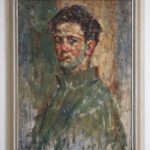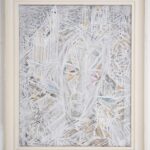
Stasiulevičius Aloyzas
Aloyzas Stasiulevičius is known as one of the reformers of Lithuanian art of the 20th century, who created a new plastic language in the 1950s and 1960s. Like the works of J. Švažas, J. Čeponis, V. Kisarauskas, V. Antanavičius at that time, A. Stasiulevičius’s works marked the retreat of modern art from the prevailing canons of academic naturalism. This greatly irritated the art leaders of that time. For example, in 1966, A. Stasiulevičius’s “Wall”, exhibited at the Exhibition of Young Painters in Vilnius, almost caused a political scandal. This work – a parable about the experience of a closed society – was made using the collage technique, which was previously unused in Lithuania. In his later works, A. Stasiulevičius “legitimized” collage as a specific element of the artistic language, significantly developed its possibilities, expanding the boundaries of expression of modern Lithuanian art.
For a decade now, as an artist, he has been particularly interested in the issue of color. Being a great colorist with an absolute color ear, Stasiulevičius refused an abundance of colors. For several years in a row, the artist devoted himself exclusively to the analysis of white color, which opened a new dimension in his work – sacredness. In recent years, the artist has been studying the possibilities of blue color, searching for new relationships between color and its meaning.
With minimal means, the painter strives for the greatest expression, plays with the most subtle overtones of color. The artist pays special attention to the quality of color – its sonority, translucency. In monochrome canvases, A. Stasiulevičius’ color becomes a concentrated gust of force. The works, inlaid with expressive flashes of contrasting colors, achieve a stained glass sonority. The color of Aloyzas Stasiulevičius’ paintings is so unique that sometimes it seems as if he were not working with mass-produced paints, but were producing them himself, unlike the old masters. Indeed, the technique used by the painter – “installing” the canvas with various materials, glazing, washing, scraping, splattering, smearing – allows you to obtain
complex colors and textures.
Aloyzas Stasiulevičius has held about 30 personal exhibitions in Lithuania and abroad, his works have been exhibited in more than 80 group exhibitions in Lithuania, in 30 exhibitions abroad – in France, Italy, Canada, Germany, Poland, Finland, Spain, Japan, the USA and elsewhere. Aloyzas Stasiulevičius’ works represented contemporary Lithuanian art in group exhibitions during the visits of the President of the Republic of Lithuania V. Adamkus to Ukraine (1998) and Turkey (1999), during the visit of the Speaker of the Seimas of the Republic of Lithuania V. Landsbergis to China (1998), and at the international Music and Art Festival “Probaltika” in Toruń (1999).
The painter’s works are in the most important Lithuanian museums – the Lithuanian Art Museum (Vilnius), the M. K. Čiurlionis Gallery (Kaunas), as well as in the collections of famous world museums and galleries – the P. Cezanne Gallery in Cannes (France); the Museum of Modern Art in Cologne (Germany, Dr. R. Ludwig’s collection); the Tretyakov Gallery in Moscow (Russia); the Sharjah
Museum (United Arab Emirates). Many of the painter’s works have found their way into the collections of private foreign collectors
The painter’s works fit perfectly into modern interiors. His paintings are exhibited at the National Drama Theatre, the M. Mažvydas Library in Vilnius, the Lithuanian Academy of Sciences, the Government Palace of the Republic of Lithuania, the Lithuanian embassies in Brussels, the Vilnius City Municipality, Santariškės, Antakalnis University Hospitals, etc.
Aloyzas Stasiulevičius has written 45 articles about art – introductions to catalogues, reviews of exhibitions and individual artists – Jonas Švažas, Antanas Gudaitis, Jutas Čeičytė, Jonas Čeponis, Vincas Kisarauskas, Vytautas Ignas, etc.
Awards:
1978 – the main prize of the Lithuanian Artists’ Union at the 4th Baltic Painting Triennial in Vilnius (Lithuania); 1982 – the name of the laureate at the 4th International Painting Triennial in Sofia (Bulgaria); 1997 – the main prize of the Ministry of Environmental Protection of the Republic of Lithuania for urban landscapes of Vilnius; 1997 – the first prize in the competition organized by the Ministry of the Interior of the Republic of Lithuania; 1999 – the main prize at the 3rd World Samogitian Exhibition in Plungė.



